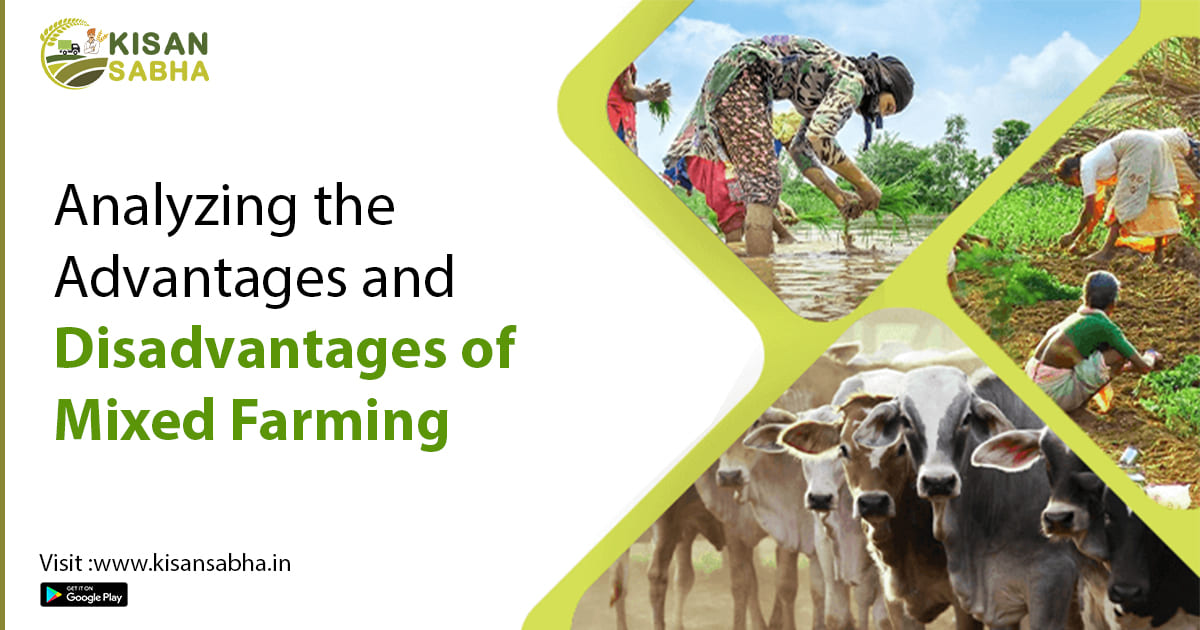Farmers have created cutting-edge methods for maximising their productivity and space. Making the most available resources may involve raising crops and cattle simultaneously or using one land for two crops. Each technique, however, has both some benefits and some drawbacks.
What is Mixed Agriculture?
A definition of mixed farming is farming that involves two or more businesses. For instance, mixed farming might be defined as the simultaneous and contiguous growing of crops and cattle. Better crops can be grown with the help of the livestock’s manure, and the improved crops can then be utilised to feed the animals. This supports a sustainable system and also offers environmental balance.
To help you better understand this sort of farming, we have covered the benefits and drawbacks of mixed farming in this blog.

Advantages and Disadvantages of Mixed Farming
Advantages:-
Diversification: Diversification is one of the main benefits of mixed farming. Growing crops and raising livestock simultaneously enables farmers to diversify their risks and reduce losses in the event of problems like crop failures, diseases, or pests harming their crops or animals. For instance, the likelihood of suffering losses rises if a farmer primarily concentrates on agricultural cultivation during a drought. But if the same farmer engages in mixed farming, growing crops and raising animals simultaneously, he or she can sell the animals for a profit and keep the farm going.
Efficient Use of Resources: Mixed farming is an efficient use of resources because the same crop is used to raise crops and livestock. For instance, once crops are harvested, animals can graze on the agricultural leftovers, which reduces the need for additional fertiliser and animal feed costs. This reduces production costs and raises profitability as a result.
Increased Productivity: Due to the efficient use of land, mixed farming increases productivity. For instance, manure from farm animals can be used to fertilise crops and improve soil fertility. As a result, farmers will receive increased harvests and money.
Risk management: By diversifying their sources of income, farmers who practise mixed farming can better handle risk. Farmers can rely on other items for income if one product fails. This reduces the possibility of a loss of all income and ensures the viability of farmers.
Sustainability: As is common knowledge, mixed farming minimises the demand for external inputs like pesticides and fertilisers. This results in less chemical use, which preserves the environment and ensures the farm’s sustainability.
Disadvantages:-
Expert Knowledge: Farmers need expert crop management knowledge and animal husbandry to practise mixed farming successfully. Farmers who lack the abilities and knowledge required to complete both tasks efficiently may find this problematic.
More Work: Because farmers must care for crops and animals, mixed farming involves more farmer labour. For some farmers, this labour-intensive technique causes exhaustion and burnout.
High Initial Capital Expenditure: Mixed farming necessitates a high initial capital expenditure. These investments include buying cattle, seeds, tools, and other things. Farmers who lack the funds to launch their farming business may find this challenging.
Disease and Pest Management: Managing diseases and pests in mixed farming presents several difficulties because they can quickly spread from animals to crops and vice versa. As a result, farmers must constantly monitor and manage their crops and cattle, which is time-consuming and expensive.
Market Risks: Because farmers must find markets for their crops and animals, mixed farming can be risky regarding product marketing. This is difficult, especially if there is a surplus of goods on the market and cheap pricing.
Also Read: How to use organic matter to improve the health of the soil?
Conclusion
Despite its difficulties, mixed farming has shown to be successful, especially in regions with limited land where resource management is necessary for farmers. In order to successfully engage in mixed farming, it is crucial to examine both the benefits and drawbacks thoroughly.




